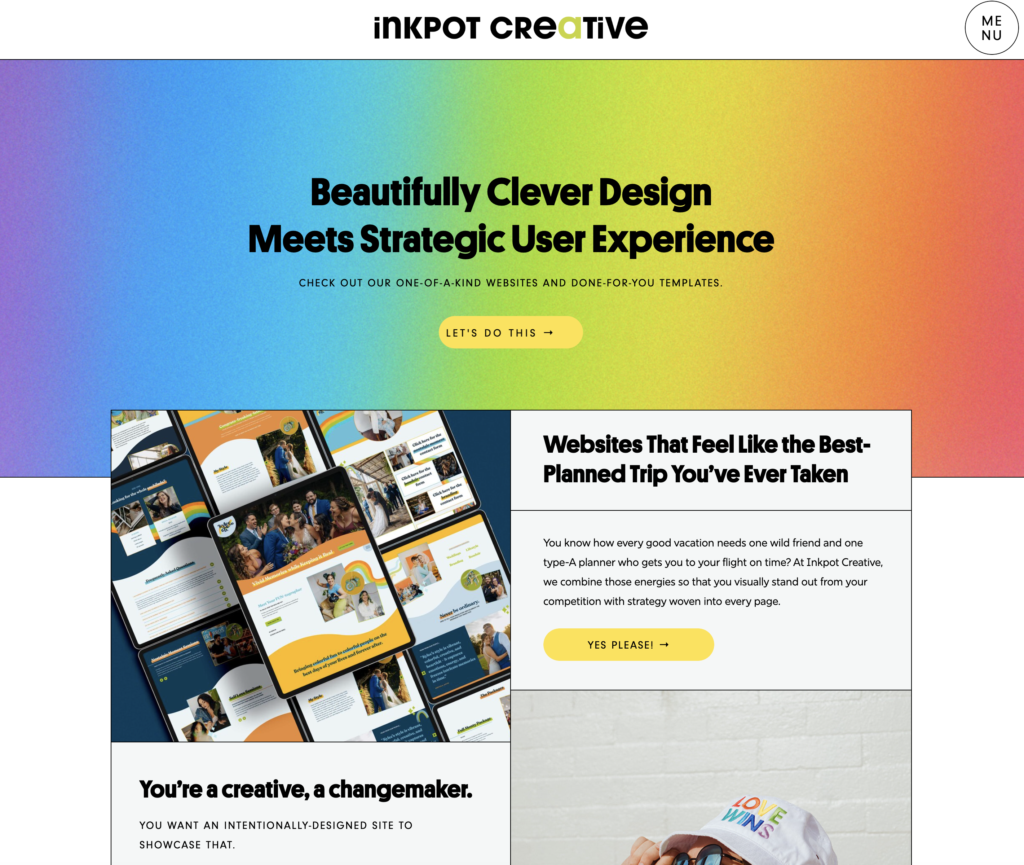Copywriting for a website combines multiple skill sets. You have to create a marketing strategy and write copy that connects. For web copy to be truly impactful, you also need to have cohesive brand messaging and a good understanding of SEO. Does that sound like a lot? We’ve got you. In this blog post, we break down why website copy matters as well as the puzzle pieces to put in place in order to get in front of dreamy clients and drive leads. We also share two real-life examples of how all of these factors come together for unique copy for two very different brands.
Why Copywriting for a Website Matters
While social media marketing feels like an inevitability for many small businesses, a website can still help your dream clients find you through SEO. Instagram’s algorithm is notoriously vague and fickle. In contrast, Google updates its algorithm far less often and with much more transparency. You can build SEO into your web copy to weather-proof your business from Meta’s constant changes.
Even if you plan to drive traffic from Instagram instead of Google, copywriting for a website is important. It shares the foundations of your brand with people who may have only encountered it in passing before. Take advantage of the opportunity to establish who you are beyond what you sell. For example, skincare company The Ordinary hones in on science and clarity as foundational values on its homepage copy. It gives the impression that people aren’t just buying face moisturizer. They’re buying the knowledge of what they’re actually putting on their skin and confidence that it’s backed by real scientific studies.
For service providers, getting clear on your brand identity in copywriting for a website can also pre-qualify leads. Visitors look through your site, decide if they’re aligned with what you’re doing, and inquire with confidence. You can rest assured that leads come from people who appreciate your work and align with your values. This can be especially helpful for service providers who hold marginalized identities and want to avoid potentially uncomfortable or even dangerous situations with clients.
Before You Get Started
Before you jump into copywriting for a website, there are a few things you need to get clear on. Knowing the answers to these questions will help you create cohesive, distinctive messaging across your site.
What are your marketing goals?
Do you want to book wedding photography clients? Do you want to sell candles? It’s possible that you have more than one marketing goal when you’re copywriting for a website. At Brandcendent, for example, we provide business coaching and SEO copywriting services. We also sell business tools, such as calculators and copy templates, for creative entrepreneurs. Before we wrote our website copy, we mapped out those goals, how they related to each other, and how they would affect the flow of content for different web pages.
What is your brand voice?
Brands often focus on distinguishing themselves visually with unique logos, colors, and fonts. Your brand voice, or how your brand “sounds,” is just as important. Brand voice includes the word choice, tone, and style you use in copywriting for a website. How casual or formal do you want to be? Do you want your brand voice to be romantic or punchy? At Brandcendent, we’ve developed a system for creating brand voice guides for our web copy clients. One of the keys to remember here is that even though your brand voice shouldn’t be completely different from how you speak, it’s less about reflecting your conversational speech than it is about appealing to your ideal client.
What are your unique selling points?
In other words, what sets you apart from other people in your industry. Many clients who come to us for copywriting for a website have trouble answering this question. We usually advise them to look through client feedback. Is there a consistent theme in what clients liked about working with you? It could be related to your product or client experience. Maybe you take the best portraits in difficult lighting situations. It could be that your strength lies in clearly communicating expectations. This is a highly important and often overlooked part of the client experience in any industry.
You may have noticed that we didn’t recommend creating a client avatar before copywriting for a website. While client avatars can be useful, they aren’t always what they’re cracked up to be. Creating an overly detailed profile of one or two people could cause you to miss out on connecting with clients you never imagined being drawn to your work. We advise against pigeonholing your clients or your work in that way.
Copy Crafted for Engagement
Once you have all of this background information compiled, you can start copywriting for a website. One guiding principle can help you stay on track with your messaging and brand voice: Copy is part of the user experience as much as your web design is.
What does it mean for your copy to be part of your user experience? When you’re copywriting for a website, remember that words tell your visitors where to go and how to engage with your content. Your CTAs tell them exactly how to reach out to you and set the tone for the conversation that will follow. “Let’s connect” has a different feeling to it than “Inquire here.”
Words also shape how your visitors are likely to feel. Should it make them feel nostalgic about family photos? Excited about launching their next business venture? Be clear about how the client experience feels. Show them how they enter into a journey in their work with you and how you’ll help them solve their problems. Just don’t get so swept up in feelings that you lose clarity on what people should expect from working with you.
Sometimes people forget that a large part of copywriting for a website is laying out what you do and how you do it. It might sound obvious, but the more obvious something is, the harder a time people tend to have explaining it in detail. If you’re a VA, for example, explain what your services entail beyond “email support.” That phrase might mean different things to different people. By laying out exactly what you mean, you’ll attract more enthusiastic leads. You’re also setting yourself up for more satisfied clients because you’ve laid out expectations from the start.
On-Brand Website Copy
All of your web pages should be united by consistent messaging, which you figured out in your prework. If you’re copywriting for a website and find yourself giving ten different reasons why you do your work, pause. You may have many motivations for running your business. Your website visitors will get confused with too many narratives, though. Our tagline is “where strategy and humanity align.” We used that to shape the copy across all of our web pages. Even though we have many reasons for offering the services we do, this narrative unites our brand in a way that’s digestible for new visitors.
Brand voice comes in as an important part of copywriting for a website with cohesive messaging. Refer back to your notes from your prework. Remember to use vocabulary and sentence structure that’s accessible. Your copy doesn’t have to be overly complicated to feel high end. In fact, it’s more likely to make people feel disengaged. Recently, Hermés ran a sunscreen ad in Vogue with the tagline “Beauty in the open air.” Their target demographic will recognize it as a play on the sunscreen’s French name, Plein air. It’s clever and elevated without three-syllable words.
SEO Copywriting for a Website
SEO is a critical part of copywriting for a website, and it’s the piece that the fewest copywriters are competent in. By incorporating SEO into your web copy, you make sure your website speaks Google’s language. That is how you show up on search engine results pages (SERPs) and drive organic traffic. No matter how stunning your website copy is, it doesn’t do you much good if clients can’t find you.
We can’t stress enough how important SEO is for your website. If you’re not an SEO expert and want to hire a copywriter for your site, make sure you ask them about their approach to SEO. They should mention the following:
- Keyword research
- Keyword validation
- Keyword density
Even if you’re not fluent in these terms, listen for them in your conversation.
2 Examples of SEO-Powered Web Copy
Taking SEO into account doesn’t mean your site has to sound just like everyone else’s. Many clients have come to us for copywriting for a website, and each leaves with SEO-powered copy that stands out from the crowd. Let’s take a look at two examples: Rose Bowman Photos and Inkpot Creative.
An Elevated Wedding Photographer’s Website
When Rose came to Brandcendent for copywriting for a website, she wanted to relaunch her site to align with shifting marketing goals. She was ready to make a more committed dive into the destination wedding market and wanted copy that reflected the intimate, elevated nature of her work. Rose is an avid traveler and reader, and her favorite clients value her artistic perspective as well as her calming presence.
We worked with Rose to create a brand voice that’s elegant yet inviting. We used approachable language inspired by classic romance novels and art. In addition to cultivating a romantic tone, we optimized each web page for a different keyword that aligned with her marketing goals. The resulting copy attracts leads more aligned with the work that Rose loves doing.

A Bold and Strategic Web Designer’s Site
We took the same approach to a very different brand for equally exciting results. Inkpot Creative is a Showit web design brand. (They made our current site, which we love!) The Inkpot team wanted copywriting for a website that combined their bold, misfit attitude and love of color with their strategic web design. In the copywriting process, we discovered that Inkpot Creative also offers an amazing client experience that sets it apart.
As SEO copywriters, we combined Inkpot’s unique selling points with a fresh voice that’s youthful but undeniably competent. From the home page, users know what to expect from working with Inkpot Creative as well as how they’ll feel about the results. The team was so excited to have this SEO-driven copy that would speak right to their dream clients.

Copy that Connects with Your Dream Clients
Do you want support copywriting for a website? At Brandcendent, we specialize in distinctive, SEO-driven copy that connects with your dream clients. We’ll work with you to:
- Clarify your marketing messaging
- Establish your brand voice
- Come up with an effective SEO strategy
- Create cohesive, compelling copy for your website
Our favorite part? We do it all in just two weeks. Our tried and true process ensures that you get everything you need so you can move forward with refreshing your site or developing a new one. Reach out to learn more!

be the first to comment